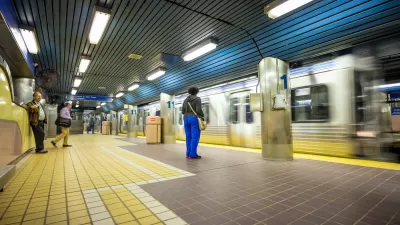The city continues to grapple with the practical implications of local planning legend Edmund Bacon's prescriptions for carless streets.
A failed 70's era experiment in carless streets still resonates in Philly, according to Jonathan Geeting. By banning cars in a ten block stretch of Center City to create the Chesnut Street Transway in 1976, planners hoped to increase foot traffic. However, the strategy actually drained the area of street life and proved catastrophic to local businesses, which fled in droves.
Philly has since "overlearned the lesson of the Transway," says Geeting, planning to the other extreme in prioritizing cars over people. But planners are beginning to recognize that a more moderate approach to the delicate car-pedestrian balance can help reinvigorate the city's streets. He writes:
"Just like with the Chestnut Street Transway, misallocating street space or designing streets to accommodate only cars or only transit can destroy wealth and render commercial properties unattractive to businesses and their customers. Bacon’s 'No Private Cars' mantra was too radical for his day, when the nation’s car culture was ascendant, and it is too radical now. But there is growing agreement that fewer private cars is key to successful neighborhood retail clusters."
Geeting argues that flexible, small-scale improvements to the built environment are the key: such changes are inexpensive and can have major impacts but are easily reversible if they prove as ill-advised as the Bacon-inspired Chesnut Street Transway.
FULL STORY: Philly Planners May Have Finally Learned the Lessons of Too Many or Too Few Cars

Alabama: Trump Terminates Settlements for Black Communities Harmed By Raw Sewage
Trump deemed the landmark civil rights agreement “illegal DEI and environmental justice policy.”

Planetizen Federal Action Tracker
A weekly monitor of how Trump’s orders and actions are impacting planners and planning in America.

Why Should We Subsidize Public Transportation?
Many public transit agencies face financial stress due to rising costs, declining fare revenue, and declining subsidies. Transit advocates must provide a strong business case for increasing public transit funding.

Understanding Road Diets
An explainer from Momentum highlights the advantages of reducing vehicle lanes in favor of more bike, transit, and pedestrian infrastructure.

New California Law Regulates Warehouse Pollution
A new law tightens building and emissions regulations for large distribution warehouses to mitigate air pollution and traffic in surrounding communities.

Phoenix Announces Opening Date for Light Rail Extension
The South Central extension will connect South Phoenix to downtown and other major hubs starting on June 7.
Urban Design for Planners 1: Software Tools
This six-course series explores essential urban design concepts using open source software and equips planners with the tools they need to participate fully in the urban design process.
Planning for Universal Design
Learn the tools for implementing Universal Design in planning regulations.
Caltrans
Smith Gee Studio
Institute for Housing and Urban Development Studies (IHS)
City of Grandview
Harvard GSD Executive Education
Toledo-Lucas County Plan Commissions
Salt Lake City
NYU Wagner Graduate School of Public Service




























